| | Yellowheaded sprucefly description | Lifecycle | Hosts | Distribution | Effects of feeding | Control strategies | Bibliography
Yellowheaded spruce sawfly (Pikonema alaskensis Rohwer), a pest of spruce, can cause serious economic and aesthetic loss to ornamental and commercially grown spruce. The feeding destruction of the needles can reduce plant growth and vigor up to two years after the damage occurs.
The yellowheaded spruce sawfly "worm" is commonly misidentified as the spruce budworm. This is most likely because both insects are spring defoliators, but this is where the similarity ends.
Yellowheaded spruce sawfly is a stingless wasp. It is a clean defoliator, leaving few partial needles in its wake, and will fed on new and old needles. Yellow headed spruce sawfly will rarely be found on all spruce trees in a planting.
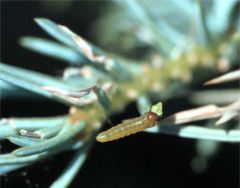 | 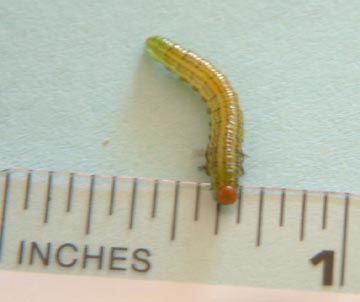
Image Courtesy: A. Bamber, CARA |
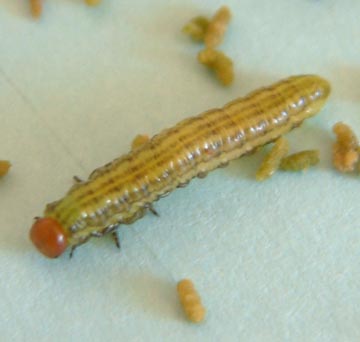
Image Courtesy: A. Bamber, CARA | 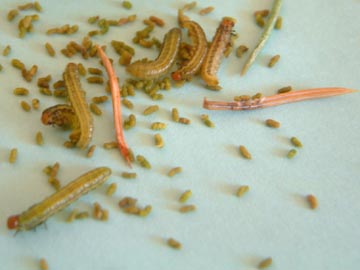
Image Courtesy: A. Bamber, CARA |
Spruce budworm is a moth, a member of the order LEPIDOPTERA. It may chew partially through needles, leaving whole needles with pieces missing or needle nubbins behind. This pest feeds only on new needles and tends to attack many trees in a stand. It makes webs which can be present until winter.
Yellowheaded Sprucefly Description
Eggs
Pearly-white and ovate, 1.3 mm long and .7 mm wide.
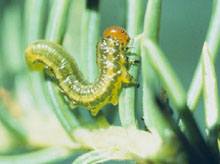
Larva
Fully-grown larva are approximately 18 mm long; resembling caterpillars but sawfly larva have 6 or more pairs of prolegs. Larva heads are mottled yellow to reddish brown. The body is yellow-green with 6 gray-green longitudinal stripes. This stripping helps camouflage the animals making them appear square like spruce tree needles. The skin has a shiny or oily appearance.
There can be color variation in this species with colors ranging from green to rose (Morton 1948). In the Canadian Maritimes, three distinct color phases, yellow, brown and green have been observed (Forbes 1949).
When disturbed the larva have a tendency to rear up their head and tail ends and emit a green viscous fluid, smelling like spruce, from their mouth.
Adult
The adult is stingless wasp. The female's ovipositor (the egg laying organ) has serrated teeth not unlike those of a wood saw.
Both males and females look the same, although the male tends to be smaller. The adults are a straw yellow with varying degrees of black markings on the head, from a few spots to a totally black. The thorax has varying degrees of black markings.
Lifecycle
Yellowheaded spruce sawfly has one generation a year. Weather plays a huge factor in the length of the lifecycle.
Eggs can hatch in as few as four days in sunny locations and 8-12 days in shaded locations. Larvae are usual found in clusters on the tree.
The first instar larvae eat only small parts of the new needles, as they develop they will first skeletonize the new needles and later consume the whole needle. Older larvae feed on the previous season’s needles. If food is very limited, they will eat the soft cortical tissue of the new growth, which can sever the central axis of the current seasons shoots.
Sawfly larvae stop feeding in mid-summer and drop to the ground to search for a cocooning site. Most cocoons, occur within the top 0.1-2 cm of the soil surface. Larva will pupate under the canopy of the tree and also away from the tree (Rau 1979).
Larvae do not pupate immediately after cocooning. They remain as prepupae for several months, and pupation occurs in late winter.
The emergence of adult sawflies is highly synchronous. Adults emerge about the time the white spruce buds begin to swell in the spring. Reported dates of emergence have ranged from 30 May though 8 June in Manitoba (Mitchener 1931).
Females fly directly to the host trees. They land on the tree and search for a suitable egg site on the partially developed current-years foliage. Females saw a slit into the base of the needle and lay a single egg. Usually all of the eggs are deposited on a single shoot, but occasionally they fly a short distance to deposit their eggs on other shoots; they will seldom fly to other trees. Females live 3-14 days without feeding (Pointing 1957). Mating is not necessary to begin the egg laying, although nonmated females produce only male offspring.
Spruce growing in full sunlight are prime egg-laying targets. Once the tree’s crown closes its susceptibility to yellowheaded spruce sawfly is greatly reduced. Higher larval numbers are found on the upper crown of the tree.
Hosts
Ornamental, shelterbelt and nursery trees grown in the open are frequent hosts. Usually trees are not attacked until the third or fifth season after planting. The insect has been reported to feed on all native North American spruce species as well as Norway spruce.
Host species include Picea mariana, (black spruce) P. pungens, (Colorado spruce) P. engelmannii, (Engelmann spruce) P. glauca, (white spruce) and P. abies (Norway spruce). It does appear host preference varies geographically. This could have a lot to do with the synchronicity between bud burst and the female sawfly emergence time (Pointing 1957). Bud burst of white spruce is usually 10 days earlier than other species (Blais 1957).
Distribution
The insect is found anywhere where Picea glauca is native. The animal ranges from Alaska to Newfoundland, south to Wyoming and Idaho across to the Northeastern United States.
Effects of Feeding
The insect’s feeding on the current year’s foliage results in a loss of the most photosynthetically active tissue and major nutrient sinks for evergreens (Kramer and Kozlowski 1979). Needle lost at this time will affect the mass and length of the current seasons shoots and reduce the amount of photosynthate available for the new shoot growth the following year (Pointing 1957, Kulman 1971a).
Heavy defoliation produces shorter shoots and closely spaced needles the year following the defoliation. Even after 1 year of moderate defoliation there will be reduced shoot and terminal length. Heavy defoliation in two or more consecutive years will reduce tree growth; terminals and lateral shoots can be 20-60% shorter. It is this loss of growth that is causes the largest economic impact.
Heavily defoliated trees produce smaller buds (Ford 1979), and the bud flush tends to occur later than in lightly defoliated trees (Cook 1976). Severe defoliation also can cause forked branches from terminal bud mortality.
Repeated defoliation over a 3-4 year period can lead to tree mortality. The defoliation caused by the insect will not be the only factor leading to the death of the tree. Lower tree vigor caused by other environmental stresses will factor into the trees ability to recover from yellowheaded spruce sawfly feeding damage.
Control Strategies
Tree health
Environmental factors do affect the insect’s host preference and the ability of the trees to withstand attack. It only makes sense that there is a link between environmental stress, poor growing conditions and yellowheaded spruce sawfly success.
- Pick planting sites carefully.
- Avoid sites with poor drainage or heavy, clay soils.
- Avoid low lying sites
- Avoid areas subject to drought, flooding, frost and exposure.
Scouting
- This is the most crucial part of a control program. The yellowheaded spruce sawfly larva is difficult to see at a casual glance and the scout needs to pay close attention to the new growth starting as soon as the growth breaks out of the bud cap.
- Begin scouting the end of May or at bud break.
- Trees damaged last year are an excellent place to start, as the insects will often be found on those same trees the following season.
- Defoliation is usually concentrated to the top third to half of the crown of the tree.
- Infested trees may be scattered in a planting or grouped together, but rarely will all the trees in a plantation be effected.
- When inspecting a tree for sawflies look for:
- partially eaten needles
- watch the south, southwest, southeast sides of the tree first
- partially eaten needles and frass littering the ground under spruce trees
- Look closely at the new needles, watching for movement of the yellowheaded spruce sawfly larva
Natural predators
Predators of the sawfly include:
- elaterid and carabid larvae
- small mammals
- birds (sparrows, robins, chickadees and cat birds),
However natural predators rarely provide satisfactory control.
Other natural control agents
- microbial pathogens
- limited food supply
- weather
Active control measures
- Hand picking, especially when numbers are small
- High pressure blast of water
- Insecticidal soap
Chemical control
Control with chemicals is not difficult, most insecticides will do an excellent job on the pest.
The best control is obtained if the larvae are treated with insecticides when they have just begun to feed. This is usually about 10 days after the bud caps have been dropped from the tree. If larvae are close to full grown, chemical treatment are not as effective and may further jeopardize the tree’s health.
Before applying any insecticide product, read the label. Follow the directions completely.
Bibliography
Cook, L. L., Mark W. Houseweart, H. M. Kulman and L. C. Thompson. 1978. Foliar Mineral Differences Related to Sawfly Defoliation of White Spruce. Environ. Entomol. 7: 780-781.
Houseweart, Mark W. and H. M. Kulman. 1976. Life Tables of the Yellowheaded Spruce sawfly, Pikonema alaskensis (Rohwer) (Hymenoptera: Tenthredinidae) in Minnesota. Environ. Entomol. 5: 859-867.
Katovich, Steven A., Deborah G. McCullough and Robert A. Haack. 1995.Yellowheaded spruce sawflyits Ecology and Management. Gen. Tech. Rep NC-179. US Forest Service. Michigan.
Rau, D. E., Mark W. Houseweart and H. M. Kulman. 1979. Distribution of Cocoons of the Yellowheaded Spruce Sawfly. Environ. Entomol. 8: 340-343.
Valovage, W. D. and H. M. Kulman. 1986. Life Table of Bessa harveyi (Diptera: Tachinidae) Parasitizing Pikonema alaskensis (Hymenoptera: Tenthredinidae). Environ. Entomol. 15: 246-250
Web
Katovich, Steven A., Deborah G. McCullough and Robert A. Haack. Yellowheaded spruce sawflyits Ecology and Management. US Forest Service. Michigan. Retrieved November 26, 2001 from the World Wide Web: http://www.na.fs.fed.us/spfo/pubs/gtr/sprucesawfly/cover.htm
Wawrzynsik, Robert. 2002 Sawflies of Trees and Shrubs. Minnesota. Retrieved November 26, 2001 from the World Wide Web: http://www.extension.umn.edu/distribution/horticulture/DG6703.html |
|